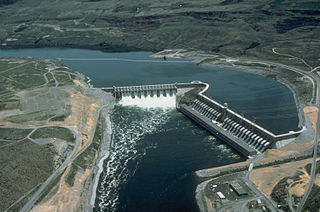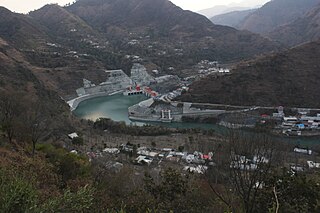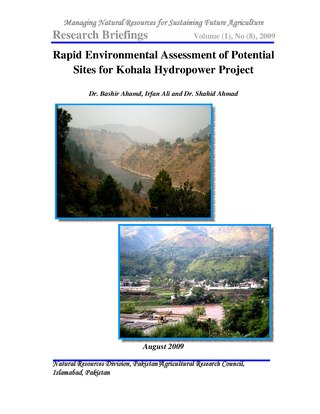
Tarbela Dam is an earth-filled dam along the Indus River in Pakistan's Khyber Pakhtunkhwa province. It is mainly located in Haripur Tehsil. It is about 20 km (10 mi) from the city of Swabi KPK, 105 km (65 mi) northwest of Islamabad, and 125 km (80 mi) east of Peshawar. It is the largest earth-filled dam in the world. The dam is 143 metres (470 ft) high above the riverbed and its reservoir, Tarbela Lake, has a surface area of approximately 250 square kilometres (97 sq mi).
Wind power is a form of renewable energy in Pakistan which makes up more than 6% of the total electricity production in the country. As of 2018, wind power capacity in Pakistan was 1,287 MW. The government is looking to increase the share of renewable energy and plans to add around 3.5 GW of wind energy capacity by 2018.

Run-of-river hydroelectricity (ROR) or run-of-the-river hydroelectricity is a type of hydroelectric generation plant whereby little or no water storage is provided. Run-of-the-river power plants may have no water storage at all or a limited amount of storage, in which case the storage reservoir is referred to as pondage. A plant without pondage is subject to seasonal river flows, so the plant will operate as an intermittent energy source. Conventional hydro uses reservoirs, which regulate water for flood control, dispatchable electrical power, and the provision of fresh water for agriculture.

The Neelum–Jhelum Hydropower Plant is part of a run-of-the-river hydroelectric power project in Azad Kashmir (AJK) designed to divert water from the Neelum River to a power station on the Jhelum River. The power station is located 42 km (26 mi) south of Muzaffarabad, and has an installed capacity of 969 MW. Construction on the project began in 2008 after a Chinese consortium was awarded the construction contract in July 2007. After many years of delays, the first generator was commissioned in April 2018 and the entire project was completed in August 2018 when the fourth and last unit was synchronized with the national grid on 13 August and attained its maximum generation capacity of 969 MW on 14 August 2018. It will generate 5,150 GWh per year at the levelised tariff of Rs 13.50 per unit for 30 years.
The Jufudu Dam (居甫渡大坝) is a gravity dam on the Lixian River, bordering the counties of Yuanjiang and Mojiang in Yunnan Province, China. It is located 56 km (35 mi) from Pu'er City. The primary purpose of the dam is hydroelectric power generation and it supports a 285 MW power station. Construction began in September 2004, and the three 95 MW generators were commissioned in December 2008. It is the fifth dam in the Lixian cascade.
The Nandipur Power Project is a 425 MW combined cycle thermal power plant situated at Nandipur near Gujranwala in the Punjab province of Pakistan. Being constructed by the China Dongfang Electric Corporation, the project was completed in March 2015. The initial cost of the project was Rs. 27 billion, but this escalated during the revised project cycle-1 and totalled Rs. 58.42 bn at completion. The power plant faced a series of hiccups during and after launching its commercial operations. Prior and after construction, the project continued to attract a number of court cases, inquiries, investigations, audits, and political and commercial disputes. The plant collapsed after 5 days of operation, launching a series of inquiries ordered by then prime minister Nawaz Sharif.
The Khan Khwar Hydropower Plant is a run-of-the-river project located near the town of Besham in the Shangla District of the Khyber Pakhtunkhwa province of Pakistan. It is situated on the Khan Khwar River, a right bank tributary of the Indus River. It is approximately 265 km from the federal capital of Islamabad and 350 km from the provincial capital of Peshawar.
The Allai Khwar Hydropower Plant is a run-of-the-river, high head project of 687 metres, located in the Battagram District on the Allai Khwar River, a left bank tributary of the Indus River in Khyber Pakhtunkhwa province, Pakistan. It is approximately 245 km from the federal capital of Islamabad and 330 km from the provincial capital of Peshawar.

China–Pakistan Economic Corridor is a 3,000 km Chinese infrastructure network project currently under construction in Pakistan. This sea-and-land-based corridor aims to secure and shorten the route for China’s energy imports from the Middle East, avoiding the existing path through the Straits of Malacca between Malaysia and Indonesia, which could be blockaded in case of war, thereby threatening China’s energy-dependent economy. Developing a deep-water port at Gwadar in the Arabian Sea and establishing a robust road and rail network from this port to the Xinjiang region in western China would serve as a shortcut, enhancing trade between Europe and China. In Pakistan, the project aims to address electricity shortages, develop infrastructure, and modernize transportation networks, while also transitioning the economy from an agriculture-based structure to an industrial one.
The Duber Khwar Hydropower Plant is located near the town of Pattan in Kohistan, Khyber Pakhtunkhwa, Pakistan on the Duber Khwar River, a right bank tributary of the Indus River. It is approximately 340 km NW from Islamabad, the federal capital of Pakistan.

Patrind Hydropower Plant is a run-of-the-river, high head project of 110 metres (360 ft), located on Kunhar River near Patrind Village of Mansehra District, right on the border of Abbottabad District of Khyber Pakhtunkhwa Province and Muzaffarabad city of Azad Kashmir, Pakistan. It is approximately 138 kilometres (86 mi) from Rawalpindi and Islamabad and about 76 kilometres (47 mi) from Abbottabad city.
Jabban (Malakand-I) Hydropower Plant (MHPP-I) is a small, low-head, run-of-the-river hydroelectric power generation station having 22 megawatt generation capacity located at the Jabban area of the Malakand District in the Khyber Pakhtunkhwa province of Pakistan. It is situated on the Swat River. It is about 210 km from Pakistan's capital Islamabad, 45 km from the city of Mardan and 7 km upstream of 20 MW Dargai Hydropower Plant (Malakand-II). It is a small hydel power generating plant constructed and put in commercial operation in July, 1938, generating an average annual yield of 122 million units (GWh) of least expensive electricity.
The Dasu Dam is a large hydroelectric gravity dam currently under construction on the Indus River near Dasu in Kohistan District, Khyber Pakhtunkhwa Province, Pakistan. It is developed by Pakistan Water and Power Development Authority (Wapda), as a key component of the company's Water Vision 2025. The project was started in 2019 but faced a delay due to funds and land acquisition disputes. Work resumed in 2020 after land acquisition and arrangements of funding facility, the World Bank agreed to contribute $700 million of the $4.2 billion as the government of Imran Khan decided to proceed ahead with the construction of the project, as part of the WAPDAs vision 2025.

The Kohala Hydropower Project is a proposed run-of-the-river, high head project of 316 meters that will be located near Kohala, in Azad Kashmir. In 2020 the project's agreement was finalised later it was formally signed in a ceremony attended by the Pakistani Prime Minister Imran khan, and Chinese ambassador.

The Azad Pattan Hydropower Project is a 700.7 MW hydroelectric power station on the Jhelum River roughly 7 km upstream of Azad Pattan Bridge in the Sudhanoti District, Azad Jammu and Kashmir, Pakistan and 90 km from Islamabad, the capital city of Pakistan. The project is scheduled for completion by 2026. In July 2020, the project's $1.5 billion investment agreement was signed between Chinese state-owned China Gezhouba Group and Pakistan, in a ceremony attended by Prime Minister Imran Khan and senior government ministers.
The Karot Hydropower Project is an asphalt-core rockfill gravity dam in Pakistan, with an installed capacity of 720 MW. The project is sponsored by Chinese state-owned company China Three Gorges Corporation (CTG).

The Engro Thar Coal Power Project (Thar-ll), also known as Engro Powergen Thar, is a coal-fired power plant developed as part of the China–Pakistan Economic Corridor by Sindh Engro Coal Mining Company and China Machinery Engineering Corporation in the Thar Block-II of the Thar Coalfield, Tharparkar District, Sindh, Pakistan 25 kilometers from the town of Islamkot near the village of Singharo-Bitra.
Lower Spat Gah Hydropower Project is a hydroelectric power project located in Kohistan, Khyber Pakhtunkhwa province of Pakistan.








